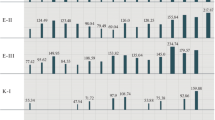Abstract
Sepia (eyed) D. melanogaster females were allowed to enter ‘bottle’ populations of wildtype D. melanogaster flies at rare, sporadic intervals. The frequency of sepia-eyed individuals in these populations was determined much more by selective forces than by numbers of immigrant individuals. Populations with no sepia individuals averaged nearly 3 immigrant individuals; those with more than 25% (homozygous) sepia flies averaged about 6 immigrants. After 34 generations, the average frequency of the sepia gene is about 0.28; this may represent the average frequency of any allele introduced into the wildtype populations by these migrant flies.
Similar content being viewed by others
References
Anxolabéhère, D. (1976). Heterosis overdominance and frequency-dependent selection in Drosophila melanogaster at the sepia locus. Evolution 30: 523–534.
Carson, H.L. (1958). Increase in fitness in experimental populations resulting from heterosis. Proc. natn. Acad. Sci. U.S.A. 44: 1136–1141.
Carson, H.L. (1958). Heterosis and fitness in experimental populations of Drosophila melanogaster. Evolution 15: 496–509.
Dobzhansky, Th. (1946). Genetics of natural populations. XIII. Recombination and variability in populations of Drosophila pseudoobscura. Genetics 31: 269–290.
Endler, J.A. (1973). Gene flow and population differentiation. Science 179: 243–250.
Haldane, J.B.S. (1948). The theory of a cline. J. Genet. 48: 227–284.
Karlin, S. & N.Richter-Dyn. (1976). Some theoretical analyses of migration selection interaction in a cline: a generalized two range environment. In: Population Genetics and Ecology, Eds. S.Karlin and E.Nevo pp. 659–706. Academic Press, New York.
MaeArthur, R. H. & E.O.Wilson (1967). The theory of island biogeography. Princeton University Press, Princeton, NY.
Vann, E.G. (1966). The fate of X-ray induced chromosomal rearrangements introduced into laboratory populations of Drosophila melanogaster. Am. Nat. 100: 425–449.
Wallace, B. (1966). The fate of sepia in small populations of Drosophila melanogaster. Genetica 37: 29–36.
Wallace, B. (1976). The structure of gene control regions and its bearing on diverse aspects of population genetics. In: Population Genetics and Ecology. S.Karlin and E.Nevo, Eds., pp. 499–521. Academic Press, New York.
Wallace, B., J.C.King, C.V.Madden, B.Kaufmann & E.C.McGunnigle (1953). An analysis of variability arising through recombination. Genetics 38: 272–307.
Author information
Authors and Affiliations
Rights and permissions
About this article
Cite this article
Wallace, B. The migration of a mutant gene into isolated populations of Drosophila Melanogaster. Genetica 50, 67–72 (1979). https://doi.org/10.1007/BF00122680
Received:
Accepted:
Issue Date:
DOI: https://doi.org/10.1007/BF00122680




